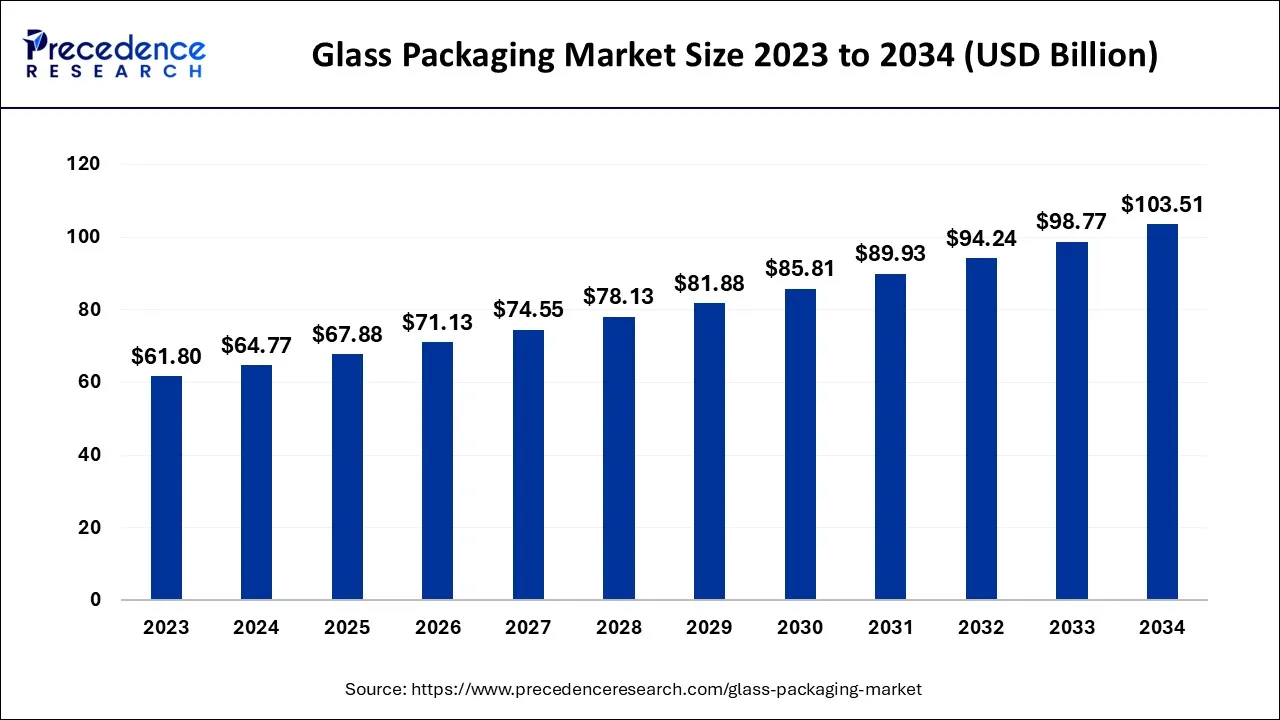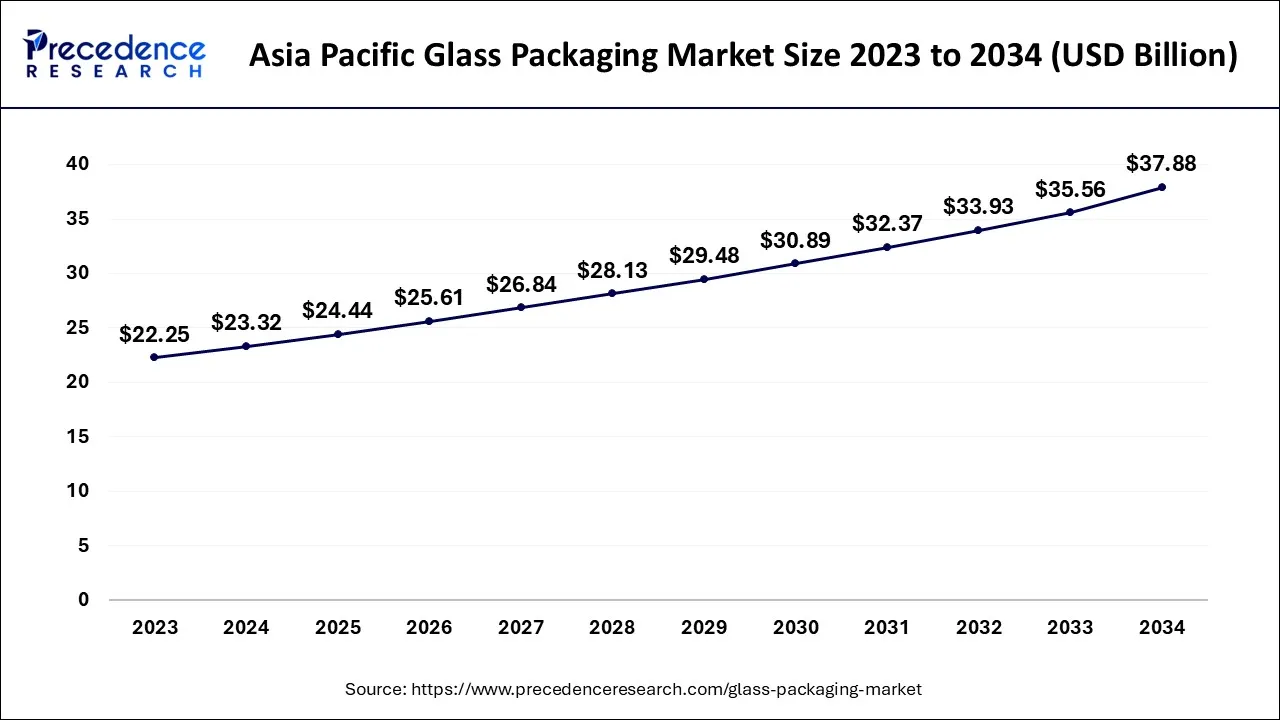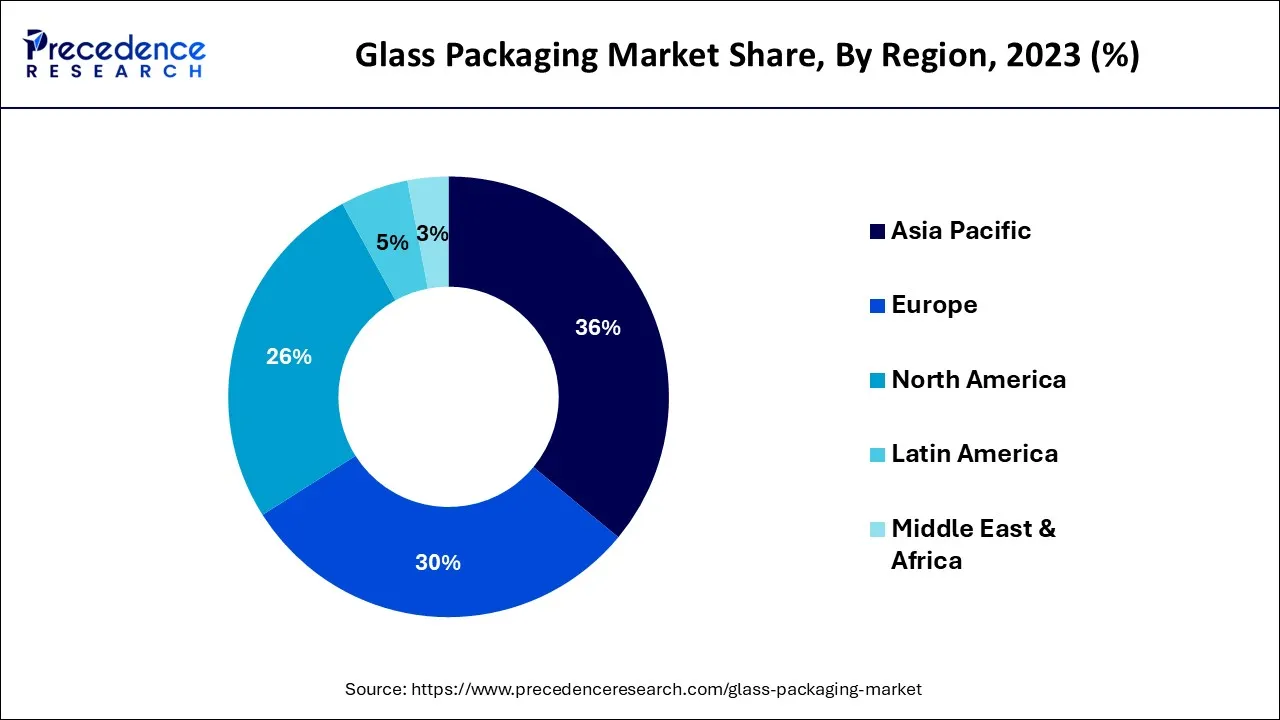List of Contents
Glass Packaging Market Size and Forecast 2025 to 2034
The global glass packaging market size was valued at USD 64.77 billion in 2024 and is anticipated to reach around USD 103.51 billion by 2034, expanding at a CAGR of 4.8% over the forecast period 2025 to 2034. The rising focus on sustainable solutions for packaging, especially in the food & beverages industry is observed to boost the growth of the glass packaging market.

Glass Packaging Market Key Takeaways
- In terms of revenue, the market is valued at $67.88 billion in 2025.
- It is projected to reach $103.51 billion by 2034.
- The market is expected to grow at a CAGR of 4.80% from 2025 to 2034.
- Asia Pacific captured the highest revenue share of around 36% in 2024.
- North America is expected to expand the fastest CAGR between 2025 and 2034.
- By End-use, the food & beverage segment generated the maximum market share of around 48% in 2024.
- By End-use, the pharmaceutical segment has held a revenue share of 25% in 2024.
- By Product, the bottles segment led the global market in 2024.
- By Product, the jars and containers segment is expected to expand the fastest CAGR between 2025 and 2034.
Asia Pacific Glass Packaging Market Size and Growth 2025 to 2034
The Asia Pacific glass packaging market size is exhibited at USD 24.44 billion in 2025 and is projected to beglass packaging market worth around USD 37.88 billion by 2034, growing at a CAGR of 4.97% from 2025 to 2034.

Asia Pacific holds the largest share of the global glass packaging market; the region is expected to maintain its dominance during the forecast period. The Asia Pacific region has a rapidly growing population, which is driving the demand for packaged goods, including food, beverages, and pharmaceuticals. The region is also experiencing rapid urbanization, which is leading to changes in consumer preferences and an increase in demand for high-quality and sustainable packaging solutions.
Glass manufacturers in Asia Pacific are investing in advanced glass production techniques, such as hot-end coating, to improve the quality and durability of glass containers. Advanced decoration techniques, such as digital printing, are used in Asia Pacific to create high-quality and eye-catching designs on glass packaging. Overall, the glass packaging industry in Asia Pacific is experiencing significant technological advancements, which are helping to improve the quality, efficiency, and sustainability of glass packaging solutions. These advancements are expected to continue to drive growth and innovation in the industry in the coming years.

North America is expected to register the fastest growth during the forecast period; the higher consumption of alcoholic beverages in the region is observed as a significant driving factor for the development of the glass packaging market in North America. Moreover, the rapid adoption of advanced technology for innovative glass packaging is another important factor for the market’s growth in the region.
In addition, the rising healthcare expenses in the region demand advanced hygienic devices or containers for healthcare center usage; this is fueling the growth of the glass packaging market in North America by expanding the prevalence of pharmaceutical end-user in the market.
- In July 2024, the Council of Scientific and Industrial Research (CSIR), a national research and development (R&D) organization in India, launched the National Mission on Sustainable Packaging Solutions program. The initiative is aimed at a net-zero future through domestic, advanced, and integrated advancements using the collective strengths of eight CSIR labs and industry partners.
Market Overview
The glass packaging market refers to the innovation, development, distribution, and utilization of glass packaging materials, including bottles, jars, and other materials for numerous end-users. Glass packaging is 100% recyclable, which makes it an attractive option for companies looking to reduce their carbon footprint.
The recyclability of glass packaging also helps to reduce waste and promote a circular economy. Several governments and private organizations are focused on promoting sustainability by implementing a number of initiatives, recycling of glass bottles, jars, and containers to develop new innovative glass products is one of the significant initiatives implemented by various governments. Such initiatives are even rapidly adopted by private companies/organizations. Such steps act as a fueling factor for the growth of the global glass packaging market.
In December 2022, Carlsberg Malaysia announced to work with Sabah Recycling Association to pilot test a three-year glass bottle recycling and community empowerment program. With this program, the company is aiming to fulfill its environmental, social, and governance agenda.
In October 2022, Grupo Petropolis and the National Confederation of Industry announced the launch of a project to improve and increase the utilization of glass throughout the supply chain. The project was launched through the National Service for Industrial Learning to solve the problem of the circularity of glass packaging chains, which focuses on reducing the generation of CO2 in the circular chain of glass, increasing the return the glass packaging, and promoting refillable packaging.
Glass Packaging Market Growth Factors
- The beverage industry is seeing a rising demand for glass packaging for storing and transporting alcoholic and non-alcoholic beverages. Glass packaging is preferred for its recyclability.
- The surge in investment by prominent market players to advance manufacturing techniques to enhance the durability and visual appeal of glass packaging contributes to market expansion.
- The increasing demand from the cosmetic and pharmaceutical industries accelerates the growth of the glass packaging market during the forecast period.
- The rising consumption of packed food and beverages is expected to boost the market growth during the forecast period.
How does technological innovation impact the glass packaging market?
Technological advancements have a significant impact on the glass packaging market, leading to improved manufacturing processes. Advancements in the glass packaging process further lead to reduced energy consumption and waste. Smart inspection systems further improve the entire production process. These systems use computer vision and ML algorithms to detect flaws accurately in glass bottles, such as bubbles, cracks, and irregular shapes. Smart inspection automatically identifies damaged bottles, which ensures that only high-quality products move on to packaging and reduces the risk of defective bottles reaching customers. Furthermore, innovations like NFC integration enhance consumer experiences by providing them with additional information about the product.
Market Scope
| Report Coverage | Details |
| Market Size by 2034 | USD 103.51 Billion |
| Market Size in 2025 | USD 67.88 Billion |
| Market Size in 2024 | USD 64.77 Billion |
| Growth Rate from 2025 to 2034 | CAGR of 4.8% |
| Largest Market | Asia Pacific |
| Fastest Growing Market | North America |
| Base Year | 2024 |
| Forecast Period | 2025 to 2034 |
| Segments Covered | Product, End-User, and Region |
| Regions Covered | North America, Europe, Asia-Pacific, Latin America, and Middle East & Africa |
Market Dynamics
Drivers
The enormous demand for premium packaging
Consumers are willingly showing interest in buying a premium range of products, especially from the personal care and cosmetics end; this is observed as a significant driver for the market’s growth. Glass packaging has a high-end and luxurious image that can enhance the appeal of premium products, such as high-end spirits, wines, and cosmetic products. As consumers increasingly associate glass packaging with premium quality, businesses can leverage this association to enhance their products' perceived value and drive sales.
Premium products often require high levels of protection during shipping and handling. Glass packaging is a durable and reliable option that can protect products from damage, ensuring they arrive at their destination in excellent condition. Glass packaging provides ample opportunities for branding, as it can be easily branded with logos and other marketing messages.
- For instance, in September 2024, Ardagh Glass Packaging-North America (AGP-North America), an operating business of Ardagh Group, introduced a new 500ml Celebration bottle in flint (clear) glass to add to its growing portfolio of American-made bottles.
Restraint
The fragile nature of glass packaging can make it more expensive to transport and handle compared to other materials. Glass packaging requires special handling and packaging to avoid breakage during transit, which can add to the overall cost of shipping. The fragility factor may not be suitable for use in specific applications, such as for products that require a high degree of impact resistance or flexibility. Due to the risk of breakage during shipping, handling, and use, there may be a higher rate of product waste associated with glass packaging compared to other materials.
This can result in additional costs for businesses and reduce the appeal of glass packaging for some consumers. Overall, the fragility of glass packaging can present challenges and additional costs that may limit its appeal for some businesses and consumers, which could potentially restrain the growth of the glass packaging market.
Opportunity
Innovation in glass material for packaging
As glass packaging becomes more innovative, it can be used for a broader range of products, expanding the market beyond traditional products such as beverages and food. Innovative glass packaging can be used for products such as pharmaceuticals, electronics, and beauty and personal care items. Innovations in glass packaging can improve its functionality, making it more convenient and practical for consumers to use.
Innovations in glass packaging can also improve its sustainability, such as by reducing the amount of material used, creating packaging that is lighter and more compact, or using recycled materials. Sustainable packaging solutions are becoming increasingly important to consumers and businesses, which can create new opportunities for glass packaging manufacturers.
- In April 2025, Glass bottle manufacturer O-I France launched a new transformation initiative called ‘Fit to Win’ to improve its operational flexibility in France. This move is designed to tackle the company’s challenges in the glass industry, driven by a decline in the wine sector, combined with excess production capacity and intense competition.
Product Insights
The bottles segment dominated the global glass packaging market in 2024 the segment will maintain its dominance during the forecast period. The versatility and durability of bottles have supported the segment’s growth. Along with this, the rising demand for recyclable materials from the food and beverage industries is observed to maintain the development of the bottles segment during the forecast period.
Rising disposable income is another factor considered for the growth of the bottle segment; as disposable income increases, consumers are more likely to purchase premium products that are often packaged in glass bottles, such as high-end wine, spirits, and cosmetics.
The jars and containers segment is anticipated to register the fastest growth during the forecast period; the growth of the jars and containers segment is attributed to the rising demand for reusable packaging for personal care and cosmetics products. As consumer preferences shift towards sustainable and eco-friendly products, the demand for glass jars and containers is expected to continue to rise, providing ample opportunities for growth and expansion in the market. Moreover, the product safety, convenience, and aesthetic appeal offered by jar and container products are observed to boost the segment’s growth.
End-User Insights
The food & beverage segment held the largest market share in 2024 the segment is predicted to maintain its dominance during the forecast period owing to the rising consumption of glass packaging for alcoholic beverages. Companies are focused on utilizing glass materials to maintain the aesthetics of bottles. In recent years, glass packaging has become a popular choice by multiple companies for packing wine, beer, spirits, and juices, as excessive light exposure can degrade the flavor, aroma, and appearance of many beverages, especially those that are sensitive to light. Dark-colored glass, such as amber or green, is often used to provide additional protection from sunlight.
On the other hand, the personal care and cosmetics segment is expected to register the fastest growth during the forecast period. As consumers are becoming more aware about environmental issues, the demand for refillable packaging options for personal care and cosmetics products is predicted to grow.
According to an article published by Beauty Packaging in August 2022, key beauty brands are gradually taking up new challenges to curb the beauty industry’s waste issues. The same report stated that in January 2022, Chanel, a luxury brand launched its new range of cosmetics products by eliminating all plastic components while opting for glass packaging including jars and containers.
The pharmaceuticals segment will remain the most attractive segment throughout the projected timeframe, factors such as protection offered for liquid dosage, the non-reactive nature of glass material, and increased regulations on pharmaceutical companies to shift towards more sustainable ways of packaging, are observed to boost the utilization of glass packaging in the pharmaceutical industry.
Glass Packaging Market Companies
- KOA Glass Co
- Amcor Plc
- Vitro Packaging
- Westpack LLC
- Piramal Glass Private Limited
- BA Glass B.V.
- Verallia
- Nihon Yamamura Glass Co ltd
Recent Developments
- In October 2024, Ardagh Glass Packaging-Europe announced a new range of lightweight wine bottles produced in Germany for the European market, said to have a carbon reduction of 12% and a recycled glass cullet level of up to 80%. The new range is produced at AGP in Germersheim, Germany, adding new lightweight bottles to the standard European range.
- In August 2024, Leading premium bottle maker Saverglass announced the addition of the MALTY glass bottle to its spirits portfolio. Designed specifically for whiskey and brown spirits, this new design is set to enhance product presentation while meeting the latest demands of eco-design. Saverglass continues to push the boundaries of glass bottle design with the introduction of the MALTY bottle.
- In May 2023, Gerresheimer increased global production proficiencies with brand-new state-of-the-art services in India. The company built a new modern plant to produce high-quality plastic closures and containers at the Kosamba site. The management ceremonially commissioned both innovations on the same day in April.
- In July 2023, Ardagh Glass Packaging, Africa, declared the contracting of a USD 95 million extension of its Nigel fabrication facility in Gauteng, South Africa. The deal is more than twice the facility's volume to provide sustainable glass packaging to meet the customers' present demand, which is expected to surge in the coming years.
- In July 2024, AGI Greenpac announced a strategic investment of â‚ą230 crores to modernize its existing furnaces, implement cutting-edge technologies, and optimize production. This initiative will enable the company to better serve the growing demand for high-quality glass packaging solutions.
- In January 2024, TricorBraun, a global packaging group, acquired glass packaging provider Glassland.
- In November 2023, Zoujaj Glass announced its plan to set up a sixth glass container production line at its Riyadh, Saudi Arabia facility. This will increase its plant’s annual capacity by approximately 25,000 MT.
- In March 2023, Bangkok Container Glass acquired Prime Packaging company for THB580 million (US$16.77 million) via its subsidiary BGC Packaging.
- In February 2023, a global leader in packaging solutions, APC Packaging, announced the launch of its new series of double-walled glass jars, specially designed for personal care and cosmetics products, in the Exploratorium at the 2023 Luxe Pack in Los Angeles. The glass jars are designed in 30 ml and 50 ml capacities and are developed with 100% sustainable materials.
Segments Covered in the Report
By Product
- Bottes
- Jars & Containers
- Ampoules Vials
- Others
By End-User
- Food & Beverages
- Pharmaceuticals
- Personal Care & Cosmetics
- Others
By Region
- North America
- Europe
- Asia-Pacific
- Latin America
- Middle East and Africa
For inquiries regarding discounts, bulk purchases, or customization requests, please contact us at sales@precedenceresearch.com
Frequently Asked Questions
Ask For Sample
No cookie-cutter, only authentic analysis – take the 1st step to become a Precedence Research client